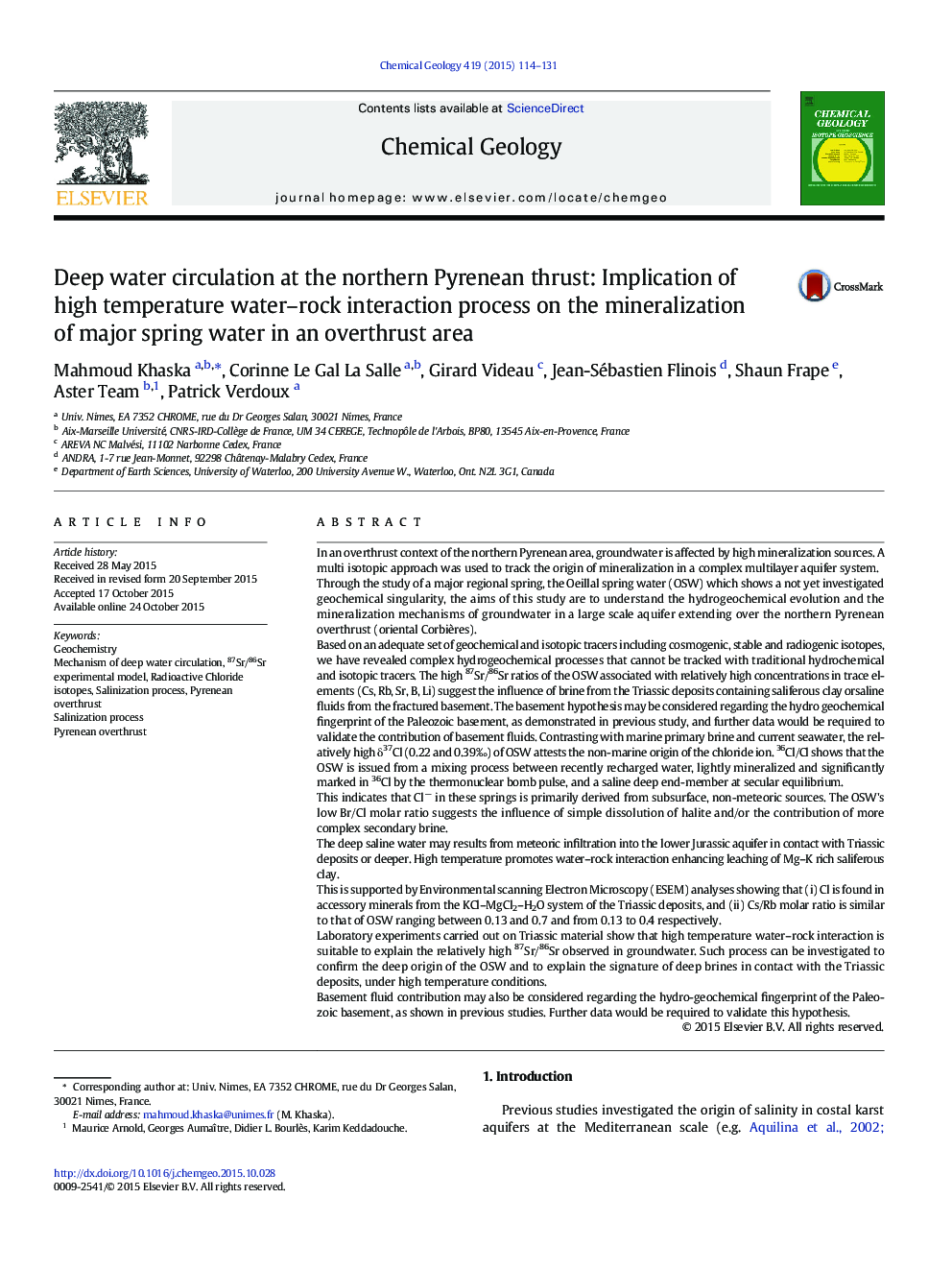| کد مقاله | کد نشریه | سال انتشار | مقاله انگلیسی | نسخه تمام متن |
|---|---|---|---|---|
| 4698406 | 1637555 | 2015 | 18 صفحه PDF | دانلود رایگان |
• Geochemical signature of Mg–K saliferous Triassic formation
• High temperature water rock interaction process
• Deep water circulation in overthrust area
• Multi isotopic approach to track complex mineralization process
• Experimental investigation of 87Sr/86Sr evolution with temperature
In an overthrust context of the northern Pyrenean area, groundwater is affected by high mineralization sources. A multi isotopic approach was used to track the origin of mineralization in a complex multilayer aquifer system.Through the study of a major regional spring, the Oeillal spring water (OSW) which shows a not yet investigated geochemical singularity, the aims of this study are to understand the hydrogeochemical evolution and the mineralization mechanisms of groundwater in a large scale aquifer extending over the northern Pyrenean overthrust (oriental Corbières).Based on an adequate set of geochemical and isotopic tracers including cosmogenic, stable and radiogenic isotopes, we have revealed complex hydrogeochemical processes that cannot be tracked with traditional hydrochemical and isotopic tracers. The high 87Sr/86Sr ratios of the OSW associated with relatively high concentrations in trace elements (Cs, Rb, Sr, B, Li) suggest the influence of brine from the Triassic deposits containing saliferous clay orsaline fluids from the fractured basement. The basement hypothesis may be considered regarding the hydro geochemical fingerprint of the Paleozoic basement, as demonstrated in previous study, and further data would be required to validate the contribution of basement fluids. Contrasting with marine primary brine and current seawater, the relatively high δ37Cl (0.22 and 0.39‰) of OSW attests the non-marine origin of the chloride ion. 36Cl/Cl shows that the OSW is issued from a mixing process between recently recharged water, lightly mineralized and significantly marked in 36Cl by the thermonuclear bomb pulse, and a saline deep end-member at secular equilibrium.This indicates that Cl− in these springs is primarily derived from subsurface, non-meteoric sources. The OSW's low Br/Cl molar ratio suggests the influence of simple dissolution of halite and/or the contribution of more complex secondary brine.The deep saline water may results from meteoric infiltration into the lower Jurassic aquifer in contact with Triassic deposits or deeper. High temperature promotes water–rock interaction enhancing leaching of Mg–K rich saliferous clay.This is supported by Environmental scanning Electron Microscopy (ESEM) analyses showing that (i) Cl is found in accessory minerals from the KCl–MgCl2–H2O system of the Triassic deposits, and (ii) Cs/Rb molar ratio is similar to that of OSW ranging between 0.13 and 0.7 and from 0.13 to 0.4 respectively.Laboratory experiments carried out on Triassic material show that high temperature water–rock interaction is suitable to explain the relatively high 87Sr/86Sr observed in groundwater. Such process can be investigated to confirm the deep origin of the OSW and to explain the signature of deep brines in contact with the Triassic deposits, under high temperature conditions.Basement fluid contribution may also be considered regarding the hydro-geochemical fingerprint of the Paleozoic basement, as shown in previous studies. Further data would be required to validate this hypothesis.
Journal: Chemical Geology - Volume 419, 25 December 2015, Pages 114–131
